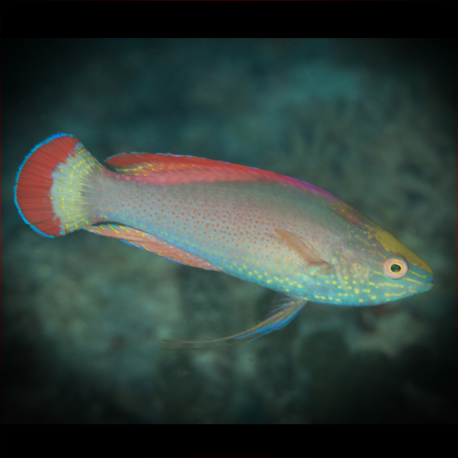More info
Datasheet
| Minimum Tank Size | 400 litres / 105.67 US gallons |
| Maximum Size | 12.0cm / 4.72inches |
| Reef Compatible | Always reef safe |
| Temperament | Might be aggressive |
| Temperature | 22.2°C / 71.96°F - 25.6°C / 78.08°F |
| Specific Gravity | 1.020-1.025 |
| Carbonate Hardness | 8-12 |
| pH | 8.1-8.4 |
General Description
The Red-margined wrasse, also known as the Pink-margin wrasse, belongs to the Labridae family, specifically the Cirrhilabrus genus. These fish are highly colorful and are well-suited for aquarium life. They exhibit a wide range of colors depending on their origin, with significant variations between males and females. Males can change and flash their colors, especially during courtship, while females may change gender from male to female and vice versa.
Aquarium Suitability
The Red-margined wrasse is suitable for most aquarium setups but may display aggression towards closely related species. It is crucial to add the largest males last if keeping multiple species together. These fish prefer large tanks, ideally around 200 gallons, and appreciate peaceful environments when first introduced. They are known to jump out of open aquariums, so a secure lid and overflow are necessary to prevent injuries.
Care and Hardiness
With an average hardiness level, these wrasses are best kept as a pair (one male and one female) or with one male and multiple females. They require a varied and high-quality diet, including frozen and flake foods of suitable size. Feeding them at least twice daily is recommended due to their high activity levels. Red-margined wrasses can be sensitive during transportation and acclimatization, requiring careful attention to their condition, especially their mouth area.
Reef Suitability
Considered always reef safe, the Red-margined wrasse is a beneficial addition to reef aquariums due to its vibrant colors and peaceful nature. They can help control unwanted invertebrates like flatworms and pyramide snails commonly found in reef environments.
Aquarium Setup
Setting up an aquarium for Red-margined wrasses involves providing ample swimming space, hiding places among live rocks, and a diverse habitat to mimic their natural environment. Maintaining water conditions within the optimal range of pH 8.1-8.4, alkalinity 8-12 dKH, salinity 1.020-1.025, and a temperature of 22.2-25.6°C is essential for their well-being.
Behaviour
These wrasses are generally peaceful but can exhibit aggression towards similar fish if space is insufficient. They are known to sleep between rocks in a cocoon of mucus and require plenty of space for swimming due to their active nature. Male Red-margined wrasses may lose coloration if not kept with females, emphasizing the importance of social dynamics in their care.
Feeding and Diet
Red-margined wrasses primarily feed on small crustaceans like krill, mysis, and artemia, as well as zooplankton such as cyclops and pods. Maintaining a varied diet is crucial for their health and coloration, as they require frequent feeding to thrive in captivity.
Dimorphism and Captive Reproduction
These wrasses exhibit significant dimorphism, with males displaying more vibrant colors and the ability to change hues during courtship. Captive reproduction of Red-margined wrasses involves creating a suitable environment that mimics their natural habitat and providing optimal conditions for breeding success.
Habitat and Distribution
Red-margined wrasses are found in the Western Pacific region, ranging from the Ryukyu Islands to Vanuatu, Fiji, and Tonga. They inhabit coral reefs and areas with plentiful hiding spots, thriving in diverse marine ecosystems characterized by rich biodiversity.

